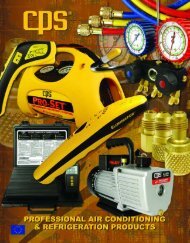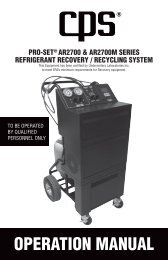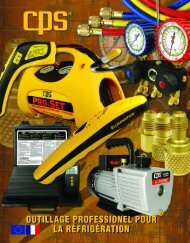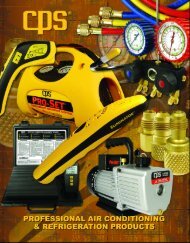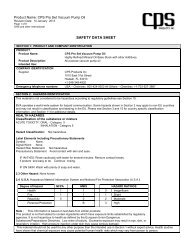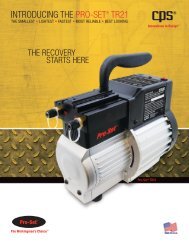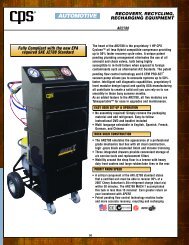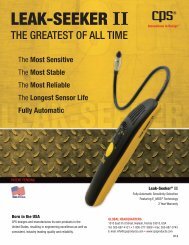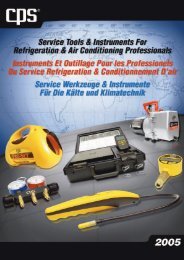afmsf msds - CPS Products
afmsf msds - CPS Products
afmsf msds - CPS Products
Create successful ePaper yourself
Turn your PDF publications into a flip-book with our unique Google optimized e-Paper software.
MATERIAL SAFETY DATA SHEET<br />
<strong>CPS</strong> AFM FLUSHING SOLUTION<br />
SECTION 1: General Information<br />
Manufacturer/Supplier Name: Phone : 248-348-4920<br />
BVA OILS Emergency : CHEMTRAC<br />
48845 West Road 1-800-424-9300<br />
Wixom, Mi 48393-6042 Date prepared: 03/21/07<br />
SECTION II a: Hazardous Ingredients > 1.0%<br />
Chemical Name CAS REG NO. % OSHA PEL ACGIH TLV STEL LD 50 LC 50<br />
Di Limonene 5989-27-5 NA NA<br />
Ethylene Glycol Butyl<br />
Ether<br />
111-76-2 0 - 7.5 25 ppm (120<br />
mg/m 3 )<br />
25 ppm (97 mg/m 3 ) 470 mg/kg 700 ppm / 7 hr<br />
SECTION II b: Carcinogenic Ingredients > 0.1%<br />
None<br />
SECTION III: POTENTIAL HEALTH EFFECTS FROM OVEREXPOSURE<br />
OVERVIEW<br />
Irritant / Flammable Liquid<br />
Routes Of Entry Inhalation: Yes Skin: Yes Eyes: Yes Ingestion: Yes<br />
Potential Health Effects (Acute and Chronic)<br />
CHRONIC: Prolonged overexposure to high concentrations of 2-butoxyethanol by skin absorption, ingestion and or inhalation has<br />
caused blood, liver and kidney effects in laboratory animals. Persons with allergies or pre-existing skin conditions should avoid contact<br />
with this product.<br />
EYE :<br />
INHALATION :<br />
INGESTION :<br />
SKIN :<br />
May cause moderate to high irritation depending on severity of exposure.<br />
Inhalation may cause dizziness, headaches, and irritate respiratory tract, aspiration and severe irritation and<br />
pulmonary edema in high concentrations may occur.<br />
Ingestion of 2-Butoxyethanol may cause nausea, red blood cell damage and possible liver and kidney damage.<br />
Can cause gastrointestinal irritation, nausea, and vomiting. Aspiration of material into lung may cause chemical<br />
pneumonitis which can be fatal.<br />
Skin contact may cause slight redness. Contains a potential skin sensitizer. Prolonged or repeated exposure<br />
can cause drying, defatting, and dermatitis of skin.<br />
SECTION IV : FIRST AID PROCEDURES<br />
EYE :<br />
SKIN:<br />
INHALATION :<br />
INGESTION :<br />
Immediately rinse eyes with water. Remove any contact lenses, and continue flushing eyes with running<br />
water for at least 15 minutes. Hold eyelids apart to ensure rinsing of the entire surface of the eyes and lids<br />
with water. Get immediate medical attention.<br />
Wash affected areas with plenty of water, and soap if available, for several minutes. Remove and clean<br />
contaminated clothing and shoes. Seek medical attention if irritation develops or persists.<br />
Remove from area to fresh air. Seek medical attention if respiratory irritation develops or if<br />
breathing becomes difficult.<br />
Give 3-4 glasses of water, but DO NOT induce vomiting. If vomiting occurs, give fluids again. Get<br />
medical attention to determine whether vomiting or evacuation of stomach is necessary. Do not give<br />
anything by mouth to an unconscious or convulsing person.
AFM FFlush MSDS Page 2 of 4<br />
SECTION V : FIRE FIGHTING PROCEDURES<br />
This product is: Combustible<br />
FLASH POINT Min 129 /F LOWER EXPLOSIVE LIMIT NOT APPLICABLE<br />
UNUSUAL HAZARDS :<br />
EXTINGUISHING AGENTS :<br />
PROTECTIVE CLOTHING :<br />
FIREFIGHTING PROCEDURES :<br />
Burning fluid may evolve irritating/noxious fumes.<br />
Agents approved for Class B Hazard. Dry chemical, CO2 foam, water fog,<br />
Firefighters should use NIOSH/MNSA approved self-contained breathing apparatus and full<br />
protective gear.<br />
Use full protective equipment and self contained breathing apparatus. If safe to do so, shut<br />
off source of spill. Cover with extinguishing agent. Use water fog to cool fire exposed<br />
containers. USE WATER CAREFULLY NEAR EXPOSED/BURNING LIQUIDS. May cause<br />
frothing and splashing of hot material.<br />
SECTION VI : SPILL OR LEAK HANDLING PROCEDURES<br />
PERSONAL<br />
PROTECTION :<br />
PROCEDURES:<br />
Wear protective clothing including splash proof goggles, rubber gloves and rubber overshoes. Remove all<br />
contaminated clothing promptly.<br />
Floor may be slippery, use care to avoid falling. Contain spill immediately with inert material (e.g. sand,<br />
earth). Transfer liquids and solid diking material to separate suitable containers for recovery or disposal.<br />
CAUTION: Keep spills and cleaning runoff out of municipal sewers and open bodies of water.<br />
SECTION VII : HANDLING AND STORAGE<br />
Avoid contact with eyes, skin and clothing.<br />
Ensure that containers are properly secured before moving.<br />
Keep container closed and keep away from oxidizing materials.<br />
Store in a cool-well ventilated area.<br />
"Empty" containers retain residue (liquid and/or vapor) and can be dangerous. DO NOT PRESSURIZE, CUT, WELD, BRAZE,<br />
SOLDER, DRILL, GRIND OR EXPOSE SUCH CONTAINERS TO HEAT, FLAME, SPARKS, STATIC ELECTRICITY, OR OTHER<br />
SOURCES OF IGNITION; THEY MAY EXPLODE AND CAUSE INJURY OR DEATH. Do not attempt to clean since residue is difficult<br />
to remove. "Empty" drums should be completely drained, properly bunged and promptly returned to a drum reconditioner. All other<br />
containers should be disposed of in an environmentally safe manner and in accordance with governmental regulations. For work on<br />
tanks refer to Occupational Safety and Health Administration regulations, ANSI Z49.1, and other governmental and industrial references<br />
pertaining to cleaning, repairing, welding, or other contemplated operations.<br />
SECTION VIII : COMPONENT EXPOSURE LIMITS & PERSONAL PROTECTION<br />
PERSONAL PROTECTION MEASURES<br />
EYE<br />
SKIN<br />
INHALATION<br />
Other Measures<br />
Safety glasses with side guards or goggles.<br />
Wear neoprene or other chemical resistant gloves and clothing as needed to prevent skin contact Gloves should<br />
be removed immediately if there is any indication of degradation or chemical breakthrough. Long sleeved<br />
clothing to minimize skin contact.<br />
Use in well ventilated area. If mist is being generated and exceeds the TWA/TLV listed above than a respiratory<br />
program meeting OSHA 1910.134 and ANSI Z88.2 requirements must be followed.<br />
Eye wash station
AFM FFlush MSDS Page 3 of 4<br />
SECTION IX : PHYSICAL & CHEMICAL PROPERTIES<br />
APPEARANCE Water White to Slight yellow tint SPECIFIC GRAVITY (WATER=1)<br />
ODOR Slight SOLUBILITY IN WATER Negligible<br />
SECTION X :<br />
STABILITY:<br />
STABILITY & REACTIVITY<br />
Stable<br />
CONDITIONS TO AVOID:<br />
MATERIAL TO AVOID:<br />
HAZARDOUS<br />
DECOMPOSITION:<br />
HAZARDOUS<br />
POLYMERIZATION:<br />
Excessive heat, formation of oil mist.<br />
Strong oxidants such as liquid chlorine, concentrated oxygen, sodium hypochlorite, calcium<br />
hypochloriate,smoke on combustion,COx, etc.<br />
Analogous compounds evolve carbon monoxide, carbon dioxide, and other unidentified fragments<br />
when burned. See Section 5.<br />
Will not occur.<br />
SECTION X I: TOXICOLOGICAL INFORMATION<br />
2-Butoxy Ethanol, 111-76-2 ORAL (LD50): Acute: 506 mg/kg [Rat].<br />
DERMAL (LD50): Acute: 406 mg/kg [Rabbit].<br />
VAPOR (LC50): Acute: 450 ppm 4 hours [Rat].<br />
CHRONIC DATA: Prolonged overexposure to high concentrations of 2-butoxyethanol by skin absorption, ingestion and inhalation<br />
has caused blood, liver and kidney effects in laboratory animals.<br />
SECTION XIII : WASTE DISPOSAL<br />
Used product must be disposed of in accordance with Federal, State, and Local environmental control regulations. Incineration is<br />
preferred.<br />
SECTION XIV : REGULATORY INFORMATION<br />
Degree of Hazard NFP HMIS HAZARD RATINGS<br />
Health 1 1 0 Insignificant<br />
Fire 2 2 1 Moderate<br />
Reactivity 0 0 2 High<br />
Specific Hazards None 3 Extreme<br />
Personal Protection Index B B 4 Extreme<br />
S a ra Ti tle Iii (Superfund<br />
Amendments and Reauthorization<br />
Act)<br />
313 REPORTABLE INGREDIENTS: 2-Butoxyethanol is subject to the reporting requirements<br />
of Section 313 of Title III of the Superfund Amendments and Reauthorization Act of 1986 and<br />
40 CFR Part 372 under the chemical category Glycol Ethers.<br />
313 Reportable Ingredients: 2-Butoxyethanol is subject to the reporting requirements of Section 313 of Title III of the<br />
Superfund Amendments and Reauthorization Act of 1986 and 40 CFR Part 372 under the<br />
chemical category Glycol Ethers.<br />
CERCLA REGULATORY:<br />
Tosca (ToxicSubstance Control Act)<br />
Carcinogenic/mutagenic Data:<br />
None of the ingredients in this product are reportable under CERCLA.<br />
TSCA STATUS: This product complies with all TSCA inventory requirements.<br />
Not listed as carcinogenic by NTP, IARC, or ACGIH or regulated as a carcinogen by OSHA.
RTI SF1 MSDS Page 4 of 4<br />
SECTION XIV: Transport Information<br />
Technical Name:<br />
Synthetic Hydrocarbon / Synthetic Terpene Blend N.O.S.<br />
D.O.T. Hazard Class: 3<br />
U.N.<br />
Product Label:<br />
RTI Super Super Flush<br />
ORM-D<br />
THE INFORMATION IN THIS MATERIAL SAFETY DATA SHEET SHOULD BE PROVIDED TO ALL WHO USE, HANDLE, STORE,<br />
TRANSPORT OR ARE OTHERWISE EXPOSED TO THIS PRODUCT. WE BELIEVE THE INFORMATION IN THIS DOCUMENT TO<br />
BE RELIABLE AND UP TO DATE AS OF THE DATE OF PUBLICATION, BUT MAKE NO GUARANTEE THAT IT IS.



